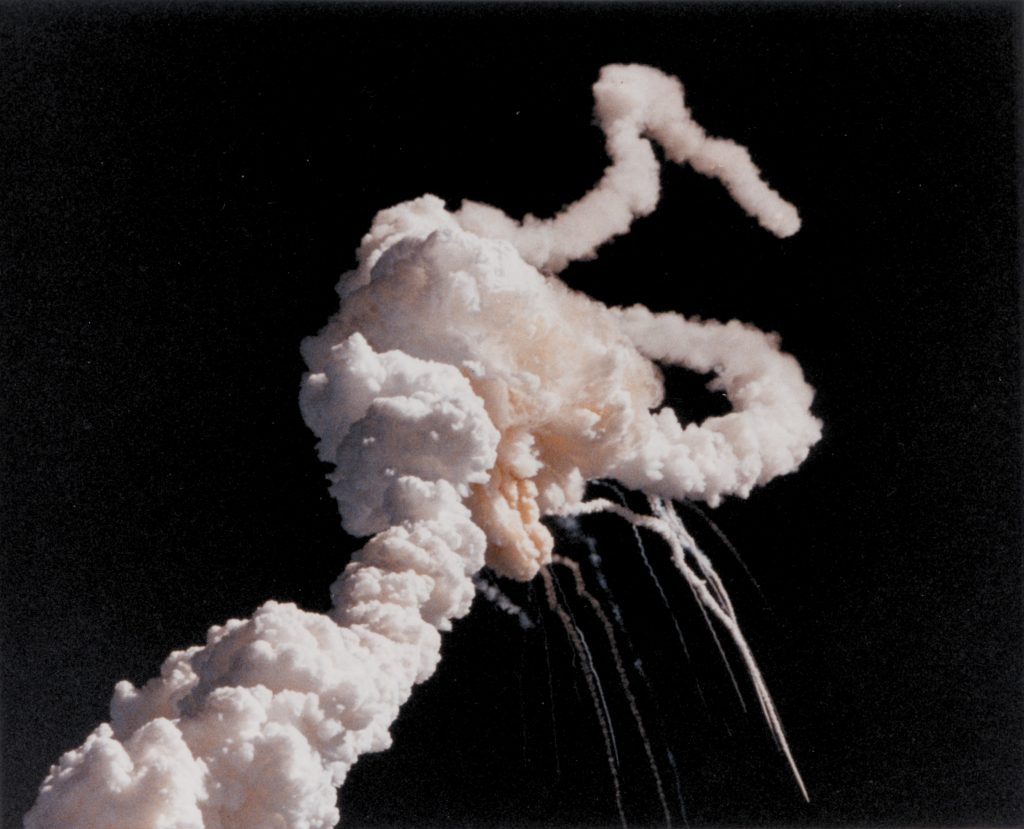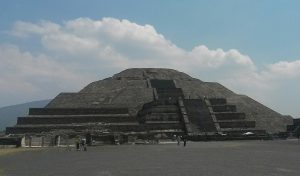On the evening of January 27th, 1986, an engineer at a little-known company told his wife, “It’s going to blow up.” That man was Bob Ebeling, an engineer for Morton Thiokol, which had been contracted to manufacture and maintain the solid rocket booster (SRB) used by NASA’s space shuttle program. On that night, he and his coworkers tirelessly pleaded with NASA officials to delay the launch of the space shuttle Challenger until temperatures were more favorable. Sadly, NASA officials did not heed these warnings, and all seven crew members of STS 51-L lost their lives.1
This story starts before that tragic day with the creation of the space shuttle program. As you can imagine, any vehicle designed for space undergoes rigorous testing and analysis before being put into use. During these early tests, engineers at the Marshall Space Flight Center saw a potentially catastrophic flaw in the two o-ring design that the SRB used in its joints and reported their concerns to NASA in 1971. NASA disregarded these concerns and did not pass this report onto Morton Thiokol for further evaluation. NASA approved the shuttle program and put the shuttles into production. By the second shuttle mission, there was serious evidence that supported the original concerns for the SRB o-ring failure. The evidence continued to stack up with each subsequent mission. In 1985 Morton Thiokol decided to redesign the joint to include an additional three inches of steel, which would grip the inner face of the joint and prevent it from rotating and potentially failing. Both NASA and Morton Thiokol agreed to continue with the launch schedule while they worked on this fix and accepted the potential for failure as an acceptable flight risk.2
Despite this risk, no shuttle had ever suffered a catastrophic failure during launch, orbit, re-entry, and no crew member had ever been injured or killed during a mission. The Challenger had already completed nine successful missions at this point and future missions were continuously being planned. This perfect record was a point of pride for NASA, and confidence continued to grow. This confidence caused NASA to be overly optimistic in their promise of how cost effective and efficient the shuttle program could be. These promises resulted in immense pressure from the government and tax payers to deliver on their promises with an overly ambitious launch schedule.3
The launch of STS 51-L had been planned as the first launch of 1986, and it would also put the first teacher in space. The addition of Christa McAuliffe, an elementary school teacher from New Hampshire, to the mission had garnered national and international attention. The launch was scheduled for January 22, 1986, but due to the delay of other missions, the launch of 51-L was pushed back several times — first to January 23rd, then to the 24th, 25th, 26th, and finally the 27th. On the morning of the 27th during regular countdown procedures, a micro switch indicated a failure of an exterior hatch-locking mechanism. By the time this issue was fixed, the winds had exceeded launch criteria. The launch was delayed yet again.4

Managers at Morton Thiokol had been watching the delays from their headquarters in Utah and were tracking the conditions with each delay. On the evening of the 27th, they saw the temperature would be below freezing at the launch site the next morning, which presented potential problems, raising concern. The shuttle and SRB had never been certified to operate in temperatures that low. Bob Ebeling had written an official memo for NASA titled “Help!” in 1985 where he described the extremely high potential for both o-rings to fail in temperatures below 40°F, but NASA had ignored it. That evening a manager at Morton Thiokol called Ebeling to ask if the shuttle could launch the following morning in the freezing temperatures. When Ebeling informed them of the extreme risk, they immediately started crunching the numbers and building their argument for the delay of the launch. Morton Thiokol and NASA held a teleconference. NASA opposed all arguments for a delay, and stated that if one o-ring failed there was a secondary mechanism that would stop a catastrophic failure from happening. Morton Thiokol engineers continued to explain that was an incorrect assumption that would surely lead to disaster. Sadly, NASA officials disagreed, and a second teleconference was scheduled. Except this time, the Morton Thiokol engineers were excluded, only management from NASA and Morton Thiokol were included. In this second call Morton Thiokol management disregarded the warnings of their own engineers and recommended that the launch proceed as scheduled.5

At 11:38AM on January 28th, 1986, STS 51-L launched from Cape Canaveral, Florida. On board were seven crew members: Francis Scobee, Michael Smith, Ronald McNair, Ellison Onizuka, Judith Resnik, Gregory Jarvis and Christa McAuliffe. At 11:39:13AM, just 73 seconds after launch, the space shuttle Challenger broke apart at an altitude of 14,000 meters. All crew members were killed when their cabin plummeted into the Atlantic Ocean three minutes after the break up.6
This disaster led to the immediate grounding of all shuttle missions. President Reagan convened a commission, called the Rogers Commission, to investigate the Challenger disaster. The results of the investigation showed the mechanical cause of the break up was a failure in both o-ring seals, which led to catastrophic structural failure. The report more importantly considered the contributing causes of the accident. It concluded that both NASA and Morton Thiokol failed to respond adequately to the potential danger of the SRB design, and instead of taking immediate action they accepted it as a flight risk. It also uncovered the large disconnect between management and engineers, which led to people who didn’t truly understand the science and math making a decision that was based on pride instead of fact.7

These tragic events unfolded more than three decades ago but are relevant today more than ever. The first private civilian space mission is rapidly approaching, and as it draws closer, we have to look closely at our past mistakes. If we don’t we are destined to repeat them. The millions who watched these events unfold have not forgotten how horrified they were, and they also remember how much the nation was shaken from this tragedy. Ebeling sums these feelings up best when describing how he feels looking back at what happened, “I could have done more. I should have done more.”8 We need to do our best to get everything right the first time, especially when failure equates to lives lost. We need to continue to focus on this as space travel becomes more prevalent in our society, and like Morton Thiokol and NASA in the ’80s, we can’t value our pride more than human lives.
- Howard Berkes, “30 Years After Explosion, Challenger Engineer Still Blames Himself,” NPR, January 28, 2016, https://www.npr.org. ↵
- Wikipedia, 2018, s.v. “Space Shuttle Challenger Disaster,” https://en.wikipedia.org/wiki/Space_Shuttle_Challenger_disaster. ↵
- Howard Berkes, “30 Years After Explosion, Challenger Engineer Still Blames Himself,” NPR, January 28, 2016, https://www.npr.org. ↵
- Diane Vaughn, The Challenger Launch Decision: Risky Technology, Culture and Deviance at NASA, Enlarged Edition (Chicago, IL: University of Chicago Press, 2016), 1-3. ↵
- Wikipedia, 2018, s.v. “Space Shuttle Challenger Disaster,” https://en.wikipedia.org/wiki/Space_Shuttle_Challenger_disaster. ↵
- Funk & Wagnalls New World Encyclopedia, 2017, s.v. “Challenger Disaster.” ↵
- Wikipedia, 2018, s.v. “Space Shuttle Challenger Disaster,” https://en.wikipedia.org/wiki/Space_Shuttle_Challenger_disaster. ↵
- Howard Berkes, “30 Years After Explosion, Challenger Engineer Still Blames Himself,” NPR, January 28, 2016, https://www.npr.org. ↵



96 comments
Daniela Cardona
I have always been interested by space and NASA, but never did much research on any of it. This article was both enlightening and alarming. It poses the notion that the Challenger disaster could have been avoided all together, that it was the outcome of negligence. Lives were lost and families were broken, all because those that are supposed to be the top minds among us did not think twice about what they were doing.I really enjoyed how this article made a historically based article become relevant with approaching times.
Nathan Alba
It seemed extremely tragic reading this whole article. How can a company like NASA go on to receive all these warnings against launch, yet continue to launch a rocket with human lives on the line? It seems utterly irresponsible and inhumane. Unfortunately those on board lost their lives, but hopefully as a society we can learn from our previous mistakes to move forward in a more positive direction in the future.
William Rittenhouse
This was such a tradgedy for NASA and the space industry as a whole. Corners should never be cut in scenarios like this. Especially when it is as important as the scenario here. When your spending millions of dollars to individually train each individual that is even sent to space, there is a lot at stake. These are 7 people that never got a chance to see their families again because of the lack of training. I believe it could have been prevented had more time been put into more rigorous testing.
Micaela Cruz
I was not born when this tragedy occurred nor have I heard many stories regarding the incident. It is truly sad to see how seven lives were lost due NASA and Morton Thiokol’s negligence. The author poses a great point as to how better planning for this upcoming civilian launch needs to occur in order to secure the safety of others to prevent another tragedy like this. This was a very interesting article and an overall good read.
Robert Rees
I had always thought that the challenger disaster was the result of an accident, not the result of negligence. I think this one of this article’s biggest strengths was the inclusion of the multiple instances in which the engineers pleaded that the O-ring issue be resolved, because it helps really drive home how big the disconnect was between the engineers and management. The other major strength I think this article has, is its tie in to modern times with the rapidly approaching first private civilian launch. Its a great connection that really helps further the author’s point.
Luis Magana
The challenge disaster was something so tragic and sudden. NASA completely blew off so many warnings wanting to be stubborn and prove everyone wrong. People were put second while NASA focused more on other factors. Disasters can occur at any given moment, but people need to be more patient and choose wisely what battle they want to fight. Weather its to do it or not it can not be impulsive.
Robert Freise
I have heard brief things about the challenger on Youtube. The disaster of the challenger shocked the nation and for America mistake was not an option, but techno-local error proved otherwise. To think that NASA to disregard the safety parts of the shuttle and they neglagation of things wrong with the Challenger was the making for an diaster. This article informed me very well and I know more about the chellenger.
Jose Fernandez
I enjoyed the article and its title really caught my attention. I think it is very well written and I can tell a lot of research was made before its creation. I was really shocked because I cannot believe NASA received several warnings about a possible failure and chose to ignore them. The warnings were there, and they still chose to send 7 people to the sky. It is horrible how this all ended. And it is sad that such catastrophe had to occur in order for NASA to fix their errors.
Eloisa Sanchez Urrea
This article definitely showed the dangerous consequences of overconfidence. NASA seemed to put their reputation and appearance above safety. There were high expectations for this launch and the craving to meet these expectations had horrible consequences. This was a well written article and it emphasized the importance of making sure that this incident is not forgotten but used as a learning experience.
Alexander Manibusan
While I am partially familiar with the Challenger explosion and with the situation of the faulty O-rings, what I did not know is that NASA just ignored the engineers’ warnings! Taking risks is one thing. Having something become a potential danger is something else. They actually put their pride before others- that’s outrageous. I hope NASA won’t make such a mistake again.